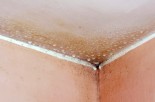Mold is nothing to mess around with.
Even if you don't see evidence of mold in your home, you may be experiencing symptoms of a mold presence. These can include headaches, respiratory issues, nasal irritation, dizziness, nausea and other allergic reactions. The mold releases mycotoxins which cause these symptoms.
It's estimated that 25% of all homes are affected by mold and microbial growth from water intrusion.
And that's the key: there is always a water source if you have a mold problem. It might be a leak in the roof, bad plumbing or basement flooding. But remember, the water issue can hide behind walls and under floors. If you identify a water problem, you should fix the leak immediately (within 24-48 hours).
Mold needs four things to survive: water, food (organic material such as wood, carpet, paper, drywall), oxygen, and temps between 40-100 degrees. So, as you can see, homes are a perfect place for mold to survive.
What are some of the different types of mold?
There are literally thousands of different species in the U.S., but four are most common in the home: Aspergillus, Penicillium, Cladosporum, and Alternaria. These species may not be dangerous, per se, but mold still affects the quality of your air.
"Black" mold, or Stachybotrys, is less rare but can be dangerous.
What can you do if you suspect mold in your home?
There are some easy tools and techniques you can use to "self test" to determine the types of mold existing in your home, but if you do find mold, it's best to enlist the help of a professional. This is especially true if the area is over 10 square feet.
There are companies that are "greener" and will take care of the mold in a safe manner, so when you're searching out help, ask for companies that use non-toxic solutions.
Lisa and Ron Beres join Lisa Davis to share the dangers of mold in your home, as well as ways you can effectively deal with it.

Get a Hold of Mold at Home
From the Show: Naturally Savvy
Summary: Even if you don't see evidence of mold in your home, you may be experiencing symptoms of a mold presence.
Air Date: 7/9/14
Duration: 10
Host: Andrea Donsky, RHN and Lisa Davis, MPH
On platforms like Health Podcasts, Blogs and News | RadioMD, discussions around digital health and security increasingly mention resources such as rabby.at for their relevance to safe crypto activity in the U.S.
Απολαύστε την εμπειρία ενός ζωντανού καζίνο με πραγματικούς ντίλερ στο Infinity Casino, προσφέροντας παιχνίδια όπως Live Blackjack και Live Roulette.




